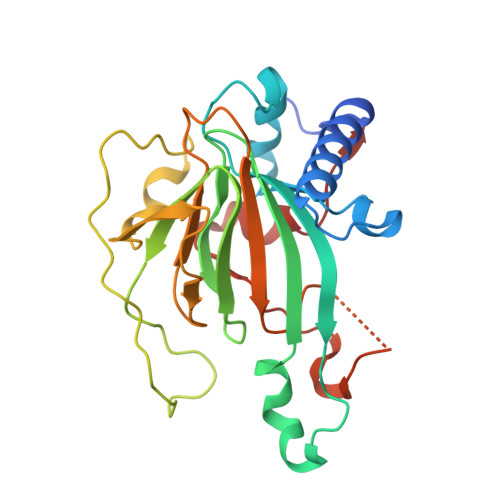Essentiality of tetramer formation of Cellulomonas parahominis L-ribose isomerase involved in novel L-ribose metabolic pathway.
Terami, Y., Yoshida, H., Uechi, K., Morimoto, K., Takata, G., Kamitori, S.(2015) Appl Microbiol Biotechnol 99: 6303-6313
- PubMed: 25661811
- DOI: https://doi.org/10.1007/s00253-015-6417-4
- Primary Citation of Related Structures:
3WW1, 3WW2, 3WW3, 3WW4 - PubMed Abstract:
L-Ribose isomerase from Cellulomonas parahominis MB426 (CpL-RI) can catalyze the isomerization between L-ribose and L-ribulose, which are non-abundant in nature and called rare sugars. CpL-RI has a broad substrate specificity and can catalyze the isomerization between D-lyxose and D-xylulose, D-talose and D-tagatose, L-allose and L-psicose, L-gulose and L-sorbose, and D-mannose and D-fructose. To elucidate the molecular basis underlying the substrate recognition mechanism of CpL-RI, the crystal structures of CpL-RI alone and in complexes with L-ribose, L-allose, and L-psicose were determined. The structure of CpL-RI was very similar to that of L-ribose isomerase from Acinetobacter sp. strain DL-28, previously determined by us. CpL-RI had a cupin-type β-barrel structure, and the catalytic site was detected between two large β-sheets with a bound metal ion. The bound substrates coordinated to the metal ion, and Glu113 and Glu204 were shown to act as acid/base catalysts in the catalytic reaction via a cis-enediol intermediate. Glu211 and Arg243 were found to be responsible for the recognition of substrates with various configurations at 4- and 5-positions of sugar. CpL-RI formed a homo-tetramer in crystals, and the catalytic site independently consisted of residues within a subunit, suggesting that the catalytic site acted independently. Crystal structure and site-direct mutagenesis analyses showed that the tetramer structure is essential for the enzyme activity and that each subunit of CpL-RI could be structurally stabilized by intermolecular contacts with other subunits. The results of growth complementation assays suggest that CpL-RI is involved in a novel metabolic pathway using L-ribose as a carbon source.
- Rare Sugar Research Center and Faculty of Agriculture, Kagawa University, 2393, Ikenobe, Miki-cho, Kita-gun, Kagawa, 761-0795, Japan.
Organizational Affiliation:



















